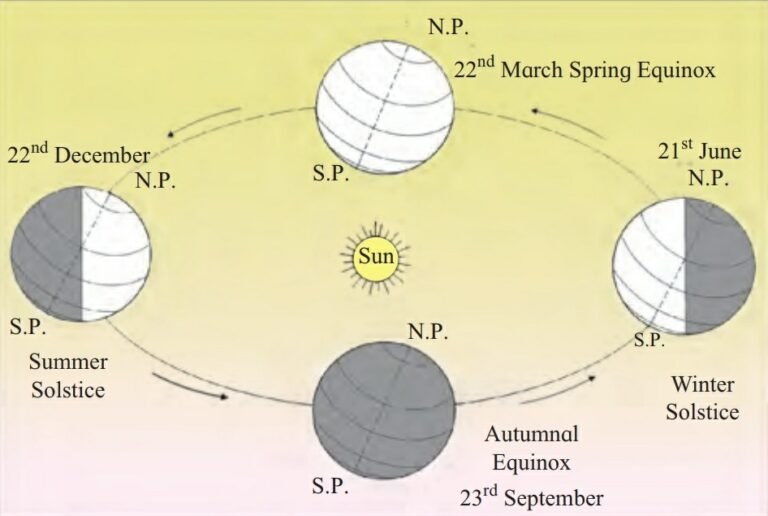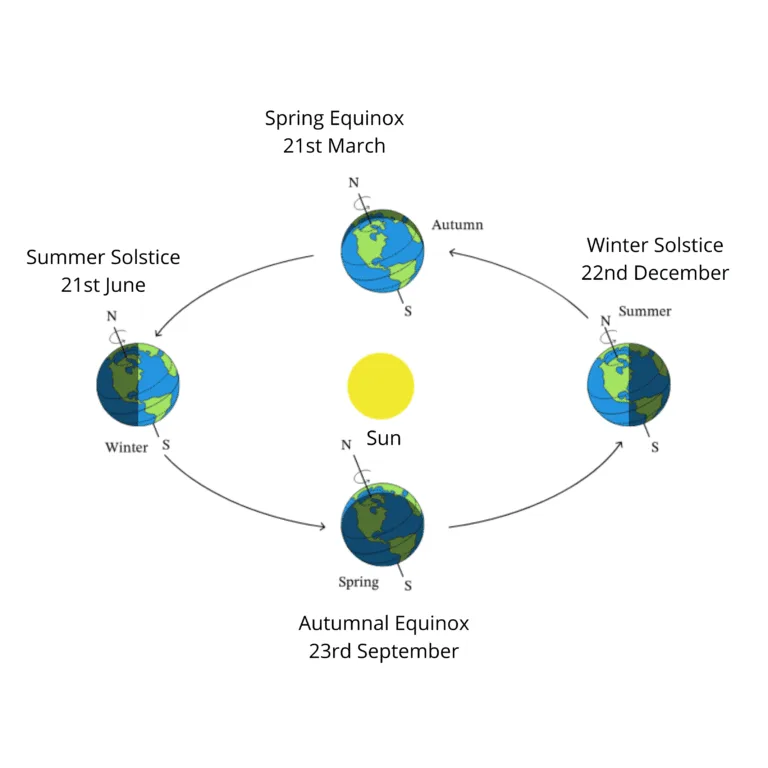Chapter 8 - How Seasons Occur - Part 2
1. Complete the statements using correct options:
(1) The apparent movement of the sun means ……..
(a) The sun revolves around the earth in a year
(b) It appears that the sun moves to the north or south in a year.
(c) The earth keeps on changing its position.
Ans: (b) It appears that the sun moves to the north or south in a year.
(2) If the axis of the earth were not tilted ……….
(a) The earth would not have rotated around itself.
(b) The earth would have revolved around the sun with greater velocity.
(c) Different parallels on the earth would have experienced the same climate throughout the year.
Ans: (c) Different parallels on the earth would have experienced the same climate throughout the year.
(3) 21st June and 22nd December are solstice days, that is, ……………..
(a) The sun starts its southward journey from Tropic of Cancer on 21st June and northward journey from Tropic of Capricorn on 22nd December.
(b) The Dakshinayan of the sun takes place between 21st June and 22nd December.
(c) The Uttarayan of the earth takes place between 21st June and 22nd December.
Ans: (a) The sun starts its southward journey from Tropic of Cancer on 21st June and northward journey from Tropic of Capricorn on 22nd December.
(4) The revolution of the earth around the Sun and the tilt of the axis of the earth together are responsible for the following seasons.
(a) Summer, rainy season, Retreat of Monsoon and winter,
(b) Summer, winter and spring
(c) Summer and winter.
Ans: (c) Summer and winter.
2. Answer the following questions.
(1) What leads to the occurrence of seasons?
Ans: Seasons occur due to the revolution of the earth, as well as due to the tilt of its axis of rotation
(2) What is the duration of the day on equinox?
Ans: On equinox, night time and day time are of equal duration of the day. That means 12 hours night time and 12 hours day time.
(3) Why is the effect of the seasons not experienced in the equatorial region?
Ans: Seasons have been decided on the basis of the duration of sunlight, equinoxes and solstices. The equatorial region receives perpendicular sun rays almost throughout the year. Hence, the climate in that region does not change at all in the year and equatorial region does not experience any change of season.
(4) Why is the sun visible for more than 24 hours during Dakshinayan in the region between the Antarctic Circle and the South Pole?
Ans: Sun Rays are never perpendicular on any of the parallels between Tropic of Cancer & the North pole or between Tropic of Capricorn & the South pole. In the period from 23rd September to 21st March i.e. during Dakshinayan, the region between the Antarctic circle and the south faces the sun. The whole Antarctic Circle falls within the zone of illumination. Hence, the sun is visible in the sky for more than 24 hours.
(5) Why are penguins not found at the North Pole?
Ans: The living world on the earth is affected by the cycle of seasons. Penguins are found at the south pole because they are native to the south pole. They have adapted to the natural conditions prevailing in the Antarctic regions of the south pole.
3. Rewrite the following statements after correcting them.
(1) The earth’s velocity varies according to the period of revolution.
Ans: The earth’s velocity varies due to the rotation of the earth.
(2) If we observe from the northern hemisphere, we see the apparent movement of the sun.
Ans: We see the apparent movement of the sun from both the northern & southern hemispheres.
(3) The dates of equinox change every year.
Ans: The dates of equinox does not change every year. They vary by a day or so.
(4) North Canada experiences summer from September to March.
Ans: North Canada experience winter from September to March.
(5) When it is summer in South Africa, Australia has winter.
Ans: When it is summer in South Africa, Australia has summer.
(6) Duration of daytime is less on the vernal and autumnal equinoxes.
Ans: Duration of daytime and nighttime is equal on the vernal and autumnal equinoxes.
4. Spot the error in the diagram given below.

Ans:
1. In the northern hemisphere, the summer solstice should be 21st June.
2. In the northern hemisphere, the winter solstice should be 22nd December.
3. In the southern hemisphere, the summer solstice should be winter solstice.
4. In the southern hemisphere, the winter solstice should be summer solstice.
5. Draw a diagram showing the cycle of seasons in the southern hemisphere.
Ans:

